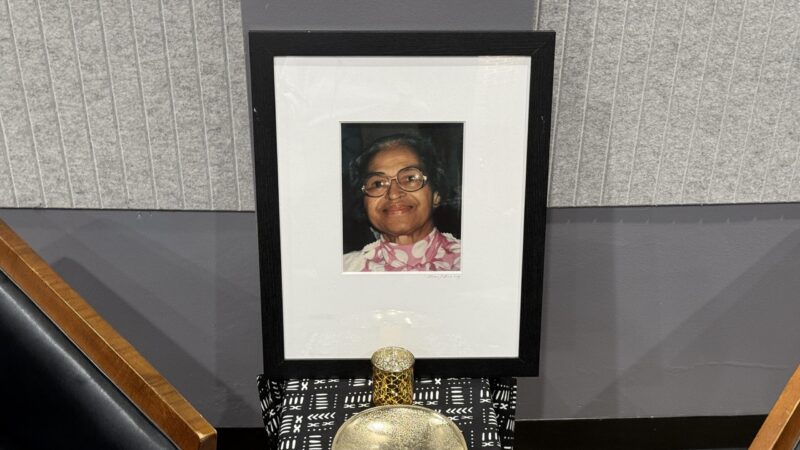The Clean Air Quest
Voris Williams says ground level ozone is a process. The Ozone Program Coordinator for the Regional Planning Commission of Greater Birmingham, Williams says the emissions of those items are only ingredients: carbon monoxide, sulfur dioxide and nitrous oxide.
But when mixed together organically with summer sunshine and lush green forests in the big bowl called Birmingham, ground level ozone is a serious problem.
“Ozone has been described as a sunburn inside your lungs. It reduces the functionality of your lungs and for people with pre-existing respiratory problems – like asthma or bronchitis or emphysema – ozone can trigger even worse episodes.”
For years, local and regional leaders have been stressing Birmingham’s air quality problems and the importance of complying with the Environmental Protection Agency’s standards for clean air.
But almost every year, for a decade or more, the area hasn’t been able to meet those standards. And consequently, Jefferson and Shelby County have lost out on billions of dollars in industrial development… more industry, more pollution.
And if all that weren’t enough, the EPA’s pollutant-measuring standards for ground-level ozone are about to get more stringent, making it tougher for major cities to comply. Federal regulators are lowering ozone threshold from .12 parts per million, to .08 parts per million. And the size at which particulate matter will be measured will drop dramatically, from 10 microns to 2.5. Microscopic in size, particulate matter can be unhealthy and cause reduced visibility.
Ron Gore is in charge of the Air Division at the Alabama Department of Environmental Management, or ADEM.
“Here in the Southeast, the new standard is somewhere in the neighborhood of 15 percent tighter than the old standard.”
Gore says the new standards could be in place for all ten of the Birmingham area monitoring stations by next year.
But despite the new regulations, things might be looking up for air quality in the Birmingham region.
At Alabama Power’s Plant Miller coal-fired steam plant, a sonic horn sounds on the new Selective Catalyctic Reduction technology, or SCR. The horn — and its very low-frequency — causes vibration through hundreds of feet of piping… just enough to keep tiny particles moving. Without the horn, the particles would settle and clog the pipe — making the SCR less efficient and pushing more nitrous oxide emissions into the atmosphere.
Operations Group Leader Tim Crump explains the catalysts inside the SCR are actually channels that allow for ammonia to react with the nitrous oxide to become more benign nitrogen and water.
“It’s like a honeycomb that the gas moves through and removes the nitrous oxide.”
When fully-operational, SCR technology at this plant and at Plant Gorgas in Walker County — can reduce their nitrous oxide emissions by as much as 80 percent. The plants are among the biggest polluters in the region, emitting nearly 2/3rds of the component for ground level ozone.
“We’re part of the problem… we know that… We’re going to be a part of the solution. That’s our commitment.”
Alabama Power Company President and CEO Charles McCrary says the commitment to reduce emissions at all of its plants statewide could top one billion dollars in the next 7 years.
The good news, says ADEM’s Ron Gore, is that with the new technology in place, it could be next year that the area meets the current EPA standards. The bad news? Those current standards will most likely be gone. Gore says it could be 2007 or later for the area to come into full compliance.
Another way the Birmingham area could clear the air is through everyday, automobile emissions. Justin Joffrion is executive director of Central Alabama Clean Cities, or C-A-C-C. Joffrion says over time his organization would like to wean individuals and — more importantly — big corporation fleets — off gasoline-powered cars and trucks and onto alternative fuels: Fuel-cell hydrogen, biodiesel blends, natural gas, ethanol blends and propane.
“Each of these fuels has so many applications where they can cut costs in a fleet or in a person’s operating budget and can also expand the lifetime cycle of the vehicle and can clean the air!”
Joffrion says a good example of alternative fuels for fleets is the Birmingham area’s mass transit system that’s been running buses on natural gas for a few years now.
Of course, the solution to Birmingham’s air quality woes won’t come in a flash. ADEMs Ron Gore says despite the fact that people and businesses are starting to take notice, there are few choices left on the table.
“There’s really no other blood to be gotten out of turnips easily. People are going to have to start facing lifestyle changes if these measures don’t work. You start talking about some of the things that people in L.A. experience: where you can’t have gasoline-powered lawnmowers or you can’t use charcoal lighter fluid or, you know, really serious things like in France where you can only drive your car on every other day.”
It’s at that time, he says, everyone starts thinking about cleaner air.
A federal jury finds Milwaukee judge guilty of obstructing immigration agents
A jury returns a guilty/not guilty verdict in the case of Hannah Dugan. The Milwaukee judge was accused of allowing an undocumented immigrant defender to evade immigration agents
Suspect in Brown University shooting found dead in New Hampshire
The suspect in the shooting at Brown University Saturday was discovered dead Thursday at a storage facility in New Hampshire.
TikTok signs deal to give U.S. operations to Oracle-led investor group
The agreement aims to resolve a yearslong standoff between the popular social media platform and the U.S. government over national security concerns tied to China's parent company, ByteDance.
A family reunion to commemorate the Montgomery Bus Boycott
This month marked the 70th anniversary of the historic Montgomery Bus Boycott. The demonstration was catalyzed when Rosa Parks refused to give up her seat on a bus. The boycott lasted over a year and is considered a spark of the Civil Rights Movement.
Mangione pre-trial hearing wraps, but judge won’t rule on evidence for months
After three weeks of testimony, a judge will now rule on whether evidence found in Mangione's backpack can be used in his state trial for the murder of UnitedHealthcare CEO Brian Thompson.
Austrian nuns await word from the Vatican on whether they can stay in their convent
The three octogenarian nuns broke out of a nursing home to go back to live in their convent, sparking a dispute with their church superior. Both sides have appealed to the Vatican for a resolution.








